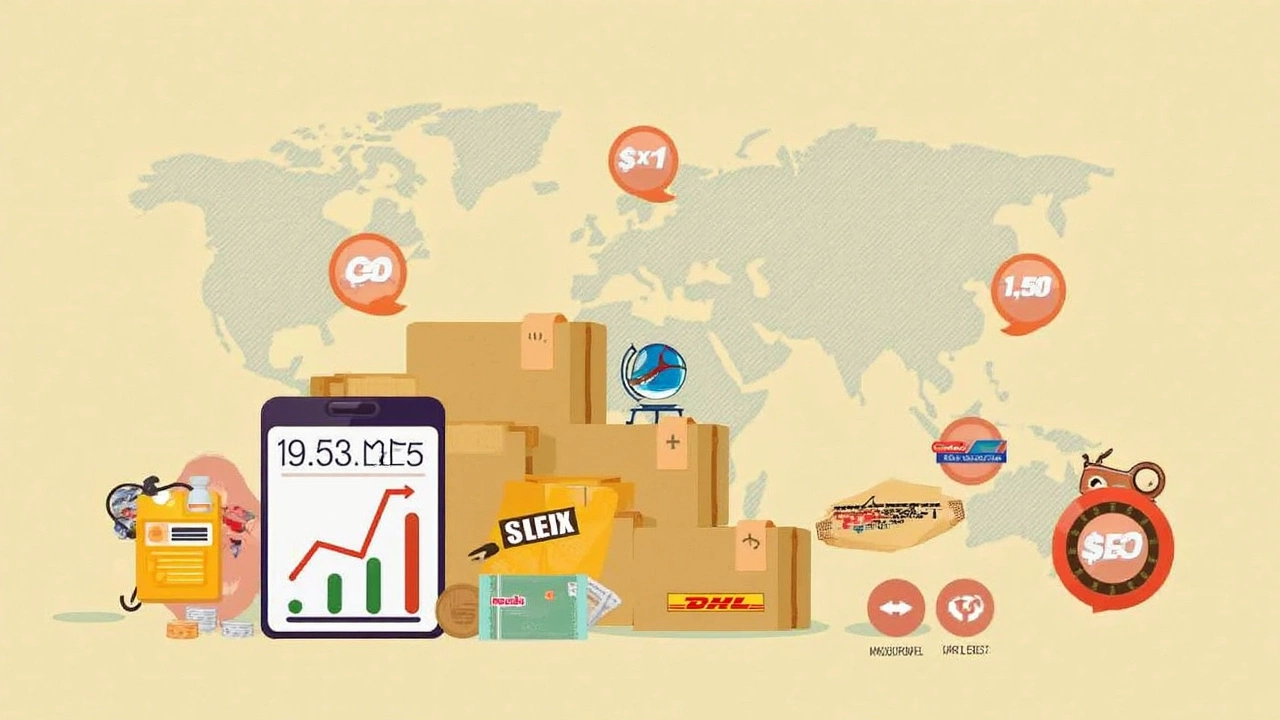Sticker shock at the post office is real the first time you send a package outside the country. The price isn’t just about distance—size, weight, speed, and even how you wrap your stuff can swing the bill up or down. You won’t pay the same to ship a hoodie to Germany as you would a phone to Australia, even if both boxes fit under your arm.
Every carrier—USPS, FedEx, UPS, DHL—has its own way of sorting the final charge, and trust me, those online calculators only tell part of the story. Taxes, handling charges, customs fees—all of these can show up on your receipt or get billed to the person at the other end, depending on who you choose and how you fill out the paperwork.
- What Decides the Cost of Shipping Abroad?
- Choosing Your Shipping Carrier
- Hidden Fees and Price Surprises
- Tips to Save on International Shipping
- Packaging and Timing: What Matters Most
What Decides the Cost of Shipping Abroad?
Cost isn’t just pulled out of thin air—international shipping charges come down to a handful of key factors. The first big one: weight and size. Lighter and smaller packages almost always cost less, but the moment your box gets bulky (even if it’s not heavy), you’ll get hit with ‘dimensional weight’ pricing. Basically, you pay for the amount of space your package takes up in the plane or truck.
Destination country matters a lot too. Sending something from New York to London is usually cheaper than New York to a remote town in the Philippines. Popular places have more flights and trucks, so they’re easier (and cheaper) to ship to. Countries with tricky customs or fewer flights tend to rack up higher rates.
Speed is another deal breaker. Economy shipping can take weeks but costs far less than express or next-day delivery. If you’re not in a rush, going for the slowest option will save you serious cash. But if time’s tight—like sending documents for a visa—expect to pay a premium.
- International shipping rates can also change fast when fuel prices jump or borders tighten up because of world events. Carriers update their prices all the time, so costs you saw last month might be different today.
- Insurance for your stuff is optional but adds a few bucks. It’s worth it for pricey or important items that you don’t want to risk.
- If you need tracking or a signature on delivery, those are add-ons that can raise the final price as well.
It’s way more than dropping a letter in the mailbox—make sure to check all these factors before you head out or book online. Knowing what actually decides the bill means you can tweak the details to avoid surprises at checkout.
Choosing Your Shipping Carrier
If you’re trying to figure out the best way to send a package abroad, picking a carrier can make a big difference in both cost and delivery time. The big names—USPS, FedEx, UPS, and DHL—dominate international shipping, but each has its own rules, prices, and real-world pros and cons. No one-size-fits-all answer here. What works for a stack of important documents might be overkill for a box of snacks heading home.
The international shipping price from USPS is usually the lowest, especially for lighter packages or small boxes. USPS offers services like First-Class Package International (budget-friendly but slow) and Priority Mail International (faster, still reasonable). The trade-off? Tracking can be iffy once your shipment leaves the US, and delivery estimates aren’t as precise outside big cities.
FedEx and UPS give you speed and top-notch tracking, but you pay for it. Express international shipping might reach Europe or Asia in just a few days, and customer service is usually better if something goes wrong. UPS Worldwide Saver and FedEx International Priority both guarantee delivery within specific time frames, but costs can jump with heavier or oversized stuff.
DHL really shines for worldwide coverage. They’re strong in places where other carriers struggle—think rural Africa or South America. DHL Express is fast and provides solid tracking from start to finish. This is the go-to for important packages or business shipments, though it’s rarely the cheapest option.
- If your package is small and you're not in a rush, USPS is usually your cheapest bet.
- For fast, guaranteed delivery and real-time tracking, look at FedEx or UPS.
- When shipping somewhere unusual or far-flung, or if reliability is your top concern, try DHL.
Before you decide, compare prices using the shipping calculators on each carrier’s website. Always check delivery timeframes and whether tracking or insurance are included for your route. And double-check what fees your recipient might get hit with—some carriers make them pay extra on arrival.

Hidden Fees and Price Surprises
So, you’ve picked a carrier and got your package ready. Don’t get too comfy—international shipping loves to throw curveballs with extra fees that aren’t always obvious upfront. Here’s the deal: just because a website quotes you a price, that doesn’t mean it covers everything. It’s easy to overlook the surprises that show up when your package crosses borders.
One big one is customs duties and import taxes. Each country sets its own rules for what comes in and how much they’ll charge, and there’s no guarantee you’ll know the exact cost ahead of time. Sometimes, the person at the other end will be stuck paying a bill before they can even pick up the box. That’s called Delivery Duties Unpaid (DDU)—if you see this, it means the receiver pays any duties or taxes. There’s also Delivery Duties Paid (DDP), where you handle the charges when you ship it out, but not all shippers offer this.
Watch out for fuel surcharges, too. Carriers like DHL and FedEx adjust these monthly based on fuel price changes. As of June 2025, fuel surcharges alone can be 10%–18% of your shipping rate—no joke.
Even little things add up. Some companies charge extra for things like remote delivery locations, weekend shipments, or handling ‘dangerous goods’ (even a bottle of perfume might count!). Make sure you double-check restrictions or you risk delays and extra fees.
One FedEx spokesperson said,
“Transparency is a big focus for us, but customers still miss customs fees and surcharges because they’re assessed by local authorities and can change without notice.”That’s why it’s smart to plug your package details into multiple carrier calculators, look for fine print, and ask about what’s not included upfront.
Tips to Save on International Shipping
International shipping gets pricey fast, but there are ways to avoid spending more than you need to. Most people don’t realize small changes can shave quite a bit off the final total. Here’s what actually works if you're looking to save:
- International shipping rates are tied to size and weight. Ditch the bulky boxes. Use the smallest, lightest package you can. Flat rate boxes from USPS or similar options abroad are often cheaper—especially if your item is heavy and fits snugly.
- Compare quotes from several carriers. USPS can be a steal for small, light parcels, while DHL or FedEx sometimes win for bigger stuff or speedy delivery. Use their official calculators and check sites like Parcel Monkey for quick comparisons.
- Print shipping labels online. Carriers usually offer a discount versus doing it at the counter. For USPS, printing at home can save up to 20% off regular post office rates.
- Don’t skip address checks. Wrong or incomplete addresses can mean your package bounces back or gets stuck in customs, and you could be on the hook for extra fees.
- Pack smart and protect your stuff, but avoid overdoing bubble wrap and padding unless necessary. Heavier packages cost more—every ounce matters when shipping global.
- If speed isn’t critical, pick economy or standard shipping. The savings over express can be big, sometimes slashing the cost in half. Timing’s everything if you’re not in a rush.
Also, ask about carrier discounts or “rewards” programs—some companies (like FedEx) give regular shippers better rates if you sign up for a free account. And keep an eye out for temporary promotions or international shipping sales, which are more common than you’d think. Every little bit counts when you send a package abroad.

Packaging and Timing: What Matters Most
Here’s where a lot of folks trip up—packaging and timing secretly control your international shipping price more than you’d think. When it comes to boxing up your stuff, carriers use either the actual weight or something called dimensional weight (basically, how much space your package hogs in the plane or truck). This means a lightweight but bulky box might cost more than a dense, heavy one. Always use the smallest, sturdiest box you can get away with, and don’t overdo the bubble wrap.
Timing is the other big hitter. Standard shipping usually costs a lot less than express or overnight, but, depending on the route and country, it can take anywhere from a week to over a month. For example, sending a package from the US to Japan by express (like FedEx International Priority) often takes just 2-3 days, but “economy” or postal services can take 10-20 days, sometimes more, especially if customs decides to get nosy.
Let’s look at average delivery times and price ranges for a simple 2kg package sent from the US in 2025:
| Carrier | Service Type | Speed (to Europe) | Speed (to Asia) | Approx. Price |
|---|---|---|---|---|
| USPS | Priority Mail Int'l | 6-10 days | 6-10 days | $70 |
| FedEx | Int'l Economy | 4-6 days | 5-7 days | $140 |
| UPS | Worldwide Expedited | 3-5 days | 4-6 days | $120 |
| DHL | Express Worldwide | 2-4 days | 2-4 days | $160 |
If you want to keep costs down and avoid headaches, stick to these packaging basics:
- Use a new, strong box—old boxes can burst or trigger extra fees.
- Fill empty space with crumpled paper instead of air pillows or tons of bubble wrap, which can make your box look oversized.
- Print the label clearly and attach it flat; don’t tape over barcodes.
- Make sure you complete the customs form honestly and in full—errors can delay your package or rack up more fees.
And for timing, unless you really need the item there in two days, skip the express options. Most people are fine waiting a week or two, unless it’s something urgent or valuable. Choosing slower options usually saves over 30% compared to next-day deliveries. Time your shipment with local holidays and big events in the destination country—customs gets backed up during Christmas, Lunar New Year, and other big holidays.





